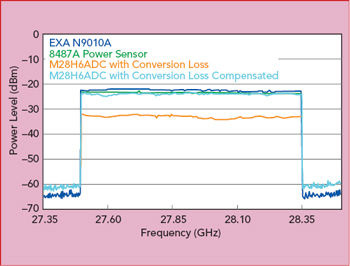
We have been hearing about the arrival of 5G for several years now: how 5G’s real-time speed, real-time interactivity and real-time connectivity will change the way we work, live and play. This year, 5G finally becomes a reality, building out official wireless carrier announcements inaugurating 5G services. Beginning in select areas in a few major metropolitan cities, 5G is expected to gain momentum as services are deployed from now into 2020. This build-out is creating the demand for cost-effective test equipment to support 5G installation and maintenance. The spectrum/signal analyzer is the most crucial item for field use, providing a view of the RF spectrum and measuring wireless metrics, important parameters to assure quality of service and avoid interference.

Figure 1 1 5G field test system comprised of a WR28 horn antenna, M28H6ADC down-converter and Keysight FieldFox analyzer.

Figure 2 The 27.5 to 28.35 GHz 5G band measured with Keysight’s EXA N9010A 44 GHz signal analyzer (a) and the M28H6ADC down-converter feeding a 6 GHz Keysight FieldFox analyzer (b).

Figure 3 Comparison of the 27.5 to 28.35 GHz measurements using the Keysight EXA N9010A, M28H6ADC/FieldFox combination and a Keysight 8487A power sensor.
Leading test equipment manufacturers have developed portable handheld signal analyzers that rival their benchtop models. With frequency coverage from Hz to various upper frequencies (i.e., 6, 9, 14, 18, 20, 26.5, 32, 44, 50 and 54 GHz), portable handheld signal analyzers can support a wide range of applications, including 5G, wireless backhaul, satellite, radar, aerospace and defense. These portable handheld signal analyzers have similar performance to the benchtop signal analyzers at a slightly lower cost.
The initial 5G rollout adds new frequency bands below 6 GHz and between 24 and 40 GHz, so a signal analyzer needs to have an upper frequency of 40 GHz to support 5G deployment and maintenance. However, continuous coverage to 40 GHz is not usually necessary, and 40 GHz signal analyzers can be expensive. OML offers a lower cost alternative, an economical solution for 5G. The M28H6ADC is a high performance yet economical block converter for the 26, 28 and 39 GHz 5G bands. Used with a 6 GHz signal analyzer with a tracking generator, the M28H6ADC enables the sub-6 GHz signal analyzer to add the 24 to 40 GHz 5G bands. This innovative solution costs much, much less than a 40 GHz signal analyzer and achieves the needed performance.
The 6 GHz signal analyzer itself will measure the sub-6 GHz 5G bands. Connecting the M28H6ADC to the signal analyzer enables the analyzer to cover the 24 to 40 GHz spectrum. Configuring the unit is simple: first connect the M28H6ADC LO input and IF output ports to the 6 GHz signal analyzer tracking generator output and RF input ports, respectively. Then, attach a WR28 horn antenna to the M28H6ADC input port, enabling over-the-air measurements (see Figure 1). The mixer’s IF output feeds the 6 GHz signal analyzer RF input, and the signal analyzer displays the captured 24 to 40 GHz spectrum on the LCD screen, showing the down-converted IF frequencies. The signal can be analyzed further by connecting the M28H6ADC IF output port to other test equipment.
The compact M28H6ADC has an IF bandwidth of 6.5 GHz and 10 dB typical conversion loss, which translates to a noise floor (i.e., minimum discernable signal) of −164 dBm at 1 Hz bandwidth. The 6.5 GHz IF bandwidth is sufficiently broad to capture the 26, 28 and 39 GHz 5G bands: 24.25 to 27.5, 27.5 to 28.35, 37 to 38.6 and 38.6 to 40 GHz. The key to transforming the 6 GHz signal analyzer into a mmWave signal analyzer is the ability of the M28H6ADC to tune the built-in tracking generator’s CW signal to the appropriate LO frequency and amplitude to drive the M28H6ADC’s down-converter. DC power for the M28H6ADC is provided from the signal analyzer’s USB port or a separate USB power pack.
Comparing the performance of a high performance 44 GHz analyzer to the M28H6ADC with a 6 GHz signal analyzer, Figure 2a shows a measurement of the 28 GHz 5G band (i.e., 27.5 to 28.35 GHz) using Keysight’s EXA N9010A 44 GHz signal analyzer. Figure 2b shows the same signal measured with the M28H6ADC, which down-converts the band to a 0.5 to 1.35 GHz IF signal and drives a Keysight FieldFox analyzer. Figure 2b has no correction for the conversion loss of the M28H6ADC or the in-line WR28 waveguide to coaxial adapter. Figure 3 overlays the two measurements and accounts for the conversion loss of the M28H6ADC. For reference, the signal measured with a Keysight 8487A power sensor is also plotted.
With the M28H6ADC added to the MxxHxADC product family, OML now offers the most comprehensive and flexible portable down-converter portfolio for mmWave applications, covering 24 to 110 GHz.
OML Inc.
Morgan Hill, Calif.
www.omlinc.com
